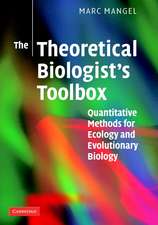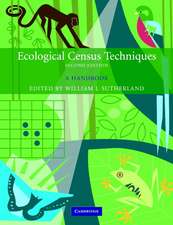The Cnidaria, Past, Present and Future: The world of Medusa and her sisters
Editat de Stefano Goffredo, Zvy Dubinskyen Limba Engleză Paperback – 11 iun 2018
| Toate formatele și edițiile | Preț | Express |
|---|---|---|
| Paperback (1) | 1880.43 lei 38-44 zile | |
| Springer International Publishing – 11 iun 2018 | 1880.43 lei 38-44 zile | |
| Hardback (1) | 1937.17 lei 38-44 zile | |
| Springer International Publishing – 20 sep 2016 | 1937.17 lei 38-44 zile |
Preț: 1880.43 lei
Preț vechi: 2474.26 lei
-24% Nou
Puncte Express: 2821
Preț estimativ în valută:
359.93€ • 391.10$ • 302.54£
359.93€ • 391.10$ • 302.54£
Carte tipărită la comandă
Livrare economică 17-23 aprilie
Preluare comenzi: 021 569.72.76
Specificații
ISBN-13: 9783319810096
ISBN-10: 331981009X
Pagini: 855
Ilustrații: XX, 855 p. 288 illus., 182 illus. in color.
Dimensiuni: 210 x 279 mm
Greutate: 0 kg
Ediția:Softcover reprint of the original 1st ed. 2016
Editura: Springer International Publishing
Colecția Springer
Locul publicării:Cham, Switzerland
ISBN-10: 331981009X
Pagini: 855
Ilustrații: XX, 855 p. 288 illus., 182 illus. in color.
Dimensiuni: 210 x 279 mm
Greutate: 0 kg
Ediția:Softcover reprint of the original 1st ed. 2016
Editura: Springer International Publishing
Colecția Springer
Locul publicării:Cham, Switzerland
Cuprins
Part 1 Genesis,Evolution, and Systematics.-1. Emergence and evolution of early life in thegeological environment- 2. Integrated evolution of cnidarians and oceanicgeochemistry before and during the Cambrian explosion- 3. Origin and earlydiversification of phylum Cnidaria: key macrofossils from the Ediacaran systemof North and South America.- 4 The new systematics of Scleractinia: integratingmolecular and morphological evidence- 5 Ceriantharia in current systematics:life cycles, morphology and genetics- 6 Origin and evolution of the nervoussystem considered from the diffuse nervous system of cnidarians. -Part 2 Zoogeography.- 7 Zoogeography ofHydrozoa: past, present and a look to the future. -8 Diversity and distributionof Octocorallia.-9 Diversity and distribution of Actiniaria. -10 Cnidarianalien species in expansion. -Part 3Calcification.-11 Calcification in the Cnidaria through time: an overviewof their skeletal patterns from individual to evolutionary viewpoints. -12 Anon-traditional stable isotope perspective on coral calcification. -13Influences of coral intra-skeletal organic matrix on calcium carbonateprecipitation. -14 From molecules to morphologies, a multiscale modelingapproach to unravel the complex system of coral calcification. -Part 4 Reproduction and Population Ecology.-15Reproduction of sea anemones and other hexacorals. -16 Sexual reproduction instony corals and insight into the evolution of oogenesis in Cnidaria. -17Sexual reproduction of Mediterranean scleractinian corals. -18 Brooding corals:planulation patterns, larval behavior, and recruitment dynamics in the face ofenvironmental change. -19 Larval dispersal and population connectivity inanthozoans. -20 Population dynamics of temperate corals in a changing climate. -Part 5 Symbiosis. -21 Microbialinteractions on coral surfaces and within the coral holobiont. -22 Associationof coral-microbes, and the ecological roles of microbial symbionts in corals. -23From one to many: the population genetics of cnidarian-Symbiodinium symbioses. -24General ecological aspects of the Anthozoa -Symbiodinium interactions in theMediterranean Sea. -25 Cnidarians and their polychaete symbionts. -26 Cassiopeaand its zooxanthellae. -27 Sea anemones and anemonefish: a match made inheaven. -Part 6 Immune system. -28Cnidarian immunity: from genomes to phenomes. -Part 7 Photobiology and Circadian Clock.-29 Corals and light: fromenergy source to deadly threat. -30 The photobiology of Symbiodinium spp.:linking physiological diversity to the implications of stress and resilience. -31Current understanding of the circadian clock within Cnidaria. -Part 8 Global Climate Change. -32Survey of cnidarian gene expression profiles in response to environmentalstressors; summarizing 20 years of research, where are we heading for?. -33Thermal-stress response of coral communities to climate change. Robert vanWoesik*, C. Cacciapaglia, C. J. Randall, Florida Institute of Technology, USA.-34 Ecological and evolutionary considerations regarding corals in a rapidlychanging environment. -35 The impact of climate change and the environment oncoral growth. -36 Cold-water corals in an era of rapid global change: are thesethe deep ocean’s most vulnerable ecosystems?.-Part 9 Medical Aspects and Applications.- 37 Unusual cnidarianenvenomations. -38 Envenomation by cnidarians and renal injuries. -39 Cubozoanenvenomations: clinical features, pathophysiology and management. -40 The roleof Cnidaria in drug discovery. -41 How venom from the magnificent sea anemone,Heteractis magnifica, kills breast and lung cancer cells. -42 Leveragingnematocysts toward human care. -43 Coral scaffolds in bone tissue engineeringand bone regeneration. -Part 10Management and Conservation.- 44 Population genetic structure of Coralliumrubrum in the Mediterranean Sea: diversity, phylogeography, and bathymetricpatterns. -45 Molecular forensics into the sea: how molecular markers can helpto struggle against poaching and illegal trade in precious corals? .- 6Advances in management of precious corals to address unsustainable anddestructive harvest techniques. -47 Conservation and restoration of coral reefsunder climate change: strategies and practice. -Part 11 In Myth and Art.- 48 The myth of the Lernaean Hydra.-49 Themyth of Medusa: Benvenuto Cellini and the Loggia de Lanzi in Florence.-50Medusa and Perseus, and the relationship between myth and science. -51Beheading the Gorgon: myth, symbolism and appropriation.
Notă biografică
Dr. Stefano Goffredo is consolidating hiscareer. His scientific initiative promises to lead marine biology towardsintegrative interdisciplinary syntheses. By extensive collaborations withleaders in different fields, such as physics, chemistry, computational scienceand photobiology SG developed multidisciplinary methodologies attacking thequestions identified by his field studies with novel laboratory tools. In hisresearch, SG has developed original aspects in the interpretation of growth and population data,population dynamics,reproductive biology and conservationmonitoring. Recently, he has expanded his interests to the biomineralization inrelation to environmental parameters.
Prof. Emeritus Zvy Dubinsky of the Mina and EverardGoodman Faculty of Life Sciences studies the response of thephotosynthetic apparatus of microalgae to the intensity and spectralcomposition of underwater irradiance and nutrient concentration. Dubinsky andhis team focus on three systems – Phytoplankton in the Red Sea, theMediterranean and Lake Kinneret; Zooxanthellae living as endosymbionts in reefbuilding corals; and algal mass cultures for the production of biodiesel and finechemicals.
Prof. Emeritus Zvy Dubinsky of the Mina and EverardGoodman Faculty of Life Sciences studies the response of thephotosynthetic apparatus of microalgae to the intensity and spectralcomposition of underwater irradiance and nutrient concentration. Dubinsky andhis team focus on three systems – Phytoplankton in the Red Sea, theMediterranean and Lake Kinneret; Zooxanthellae living as endosymbionts in reefbuilding corals; and algal mass cultures for the production of biodiesel and finechemicals.
Textul de pe ultima copertă
Thisvolume presents a broad panorama of the current status of research ofinvertebrate animals considered belonging to the phylum Cnidaria, such as hydra, jellyfish, sea anemone, and coral. In this book the Cnidarians aretraced from the Earth’s primordial oceans, to their response to the warming andacidifying oceans. Due to the role of corals in the carbon and calcium cycles,various aspects of cnidarian calcification are discussed. The relation of theCnidaria with Mankind is approached, in accordance with the Editors’ philosophyof bridging the artificial schism between science, arts and Humanities. Cnidarians' encounters with humans result ina broad spectrum of medical emergencies that are reviewed. The final section ofthe volume is devoted to the role of Hydra and Medusa in mythology and art.
Caracteristici
unique, topical, multi-level, interdisciplinary coverage of Cnidaria
the reader through the earliest evolution of the taxon and the ramification of
Exploresthe Cnidaria genesis, evolution and systematics, its zoogeography,calcification, reproduction, symbiosis, photobiology, and global climate change,and gives insight in its immune system, medical aspects
Looksat the molecular and genomic make-up; ecology and physiology; use in jewelry;invasion of human imagination in art and myth
Bridgesartificial schism between science, arts and Humanities
the reader through the earliest evolution of the taxon and the ramification of
Exploresthe Cnidaria genesis, evolution and systematics, its zoogeography,calcification, reproduction, symbiosis, photobiology, and global climate change,and gives insight in its immune system, medical aspects
Looksat the molecular and genomic make-up; ecology and physiology; use in jewelry;invasion of human imagination in art and myth
Bridgesartificial schism between science, arts and Humanities














